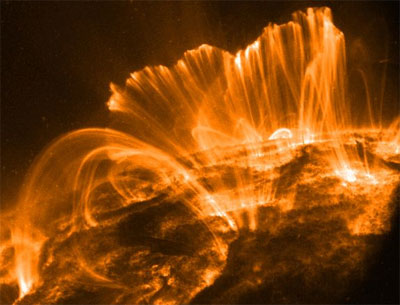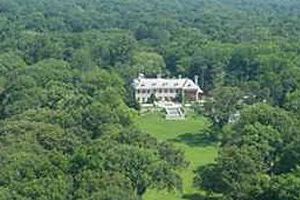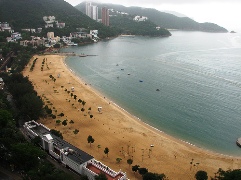How much do we need to worry?
So, do we really need to worry about a huge solar storm burning out the electrical systems of half the world in 2013? Masochists that we are here at the Telegraph, we love to shoot down our own stories, and I was cracking my knuckles for this one. It’s got all the ingredients – white-coated authority, grave warnings of impending doom, exciting sciencey nuclear nemesis in space. NASA! Solar flares! Planes falling out of the sky! Etc.

But I read the piece, and spoke to the reporter, and – while always remembering that I am no more an astrophysicist than I am a black belt in tae kwon do – it sounded pretty solid. Dr Richard Fisher, the director of Nasa’s Heliophysics division, is very clear in the quotes, and our reporter, Andrew Hough, was very careful to check his facts with Dr Fisher before publishing. It sounds like a lot of serious people think that this is a real danger.
Apparently the concern is in 2013, the sun will reach a stage of its cycle when these large events are more likely. This might strike you as a bit strange, as you’ve probably heard (as have I) that the sun has been especially active for the last half-century or so and is expected to die down in the next couple of years – I spoke to Marcus Chown, the physicist and author of We Need to Talk about Kelvin, who said “Solar activity has been abnormally high for the past 50 years, but the extremely feeble start to the latest 11-year cycle suggests this activity is coming to an end and things are going to be quiet on the Sun for quite a few years.” Dr Ruth Bamford, a plasma physicist at the Rutherford-Appleton Laboratory, agrees: “The sun has been particularly quiet for the last few years in a protracted solar minimum. It has just woken up, as it were, and started its usual 11-year cycle a bit later than most.”
So what’s going on? Well, something similar has happened before. In 1859 a huge solar storm burned out telegraph wires across Europe and the United States. Dr Stuart Clark has written a book, The Sun Kings, about when that happened. He says that the “Carrington flare”, as it was known, “smothered two-thirds of the Earth’s skies in a blood-red aurora a night later, and crippled all of global navigation and global communication, such as it was at that time. Compasses span uselessly and the telegraph network went down as phantom electricity surged through the wire.”
The sun had indeed been running at a record high for the latter half of the 20th century, and has now died down to its lowest level for a century. But Dr Clark warns that “average levels of solar activity has fallen does not mean that the Sun is immune from large flares or even giant ones. Low average levels of activity may even promote the giant flares.
“Perhaps like earthquakes, when there are constant flares/tremors the energy is dissipated evenly over long periods of time. But in periods of quiet, that energy can build up and then suddenly be released in a giant event. This remains speculation, however.”
2013 is when the next peak in the sun’s cycle of activity is expected, and while we cannot predict individual flares, Dr Clark says that the largest flares are often shortly after the peak.

Of course, if a proper “Carrington event” happens again, it has the potential to be far more problematic now than in 1859 when electric communication was barely in its infancy. Dr Clark says “There is absolutely no reason to believe that we are heading for solar armageddon in 2013, but sooner or later we should expect there to be another Carrington event and that is what these scientists [at NASA] are trying to prevent. Legislation in the US has just passed Congress to help harden the grid against solar flares.”
So – it’s a real thing, and we should be concerned. But preventive measures can be taken – satellites can be sent offline during big flares, power grids and communication networks can be shielded against electromagnetic radiation and so on. As Dr Bamford says: “The extreme events like the 1859 Carrington Event are 1-in-100-year probabilities, about the same probability as a storm of the level of Katrina hitting New Orleans – and New Orleans did not build their defences to withstand the extreme-but-unlikely magnitude. 100 years isn’t that long.
“But the end of the world it is not. Maybe as disruptive as an ash cloud, but not as protracted I’m sure.” She gives examples of precautions, like a GPS backup system called eLoran, or active mini-magnetosphere shielding for astronauts and satellites that her team have designed.
Of course, if those precautions are taken, and actually work, and no damage is done, then everyone will cry that it was all a big fuss over nothing, like they always do. So the scientists can’t win, really. But that’s just how it is.
A Guide
An Electromagnetic Pulse (EMP), is generated from the detonation of a nuclear device. A similar waveform is created by extreme solar activity, such as that which was experienced in 1859, 1921, 1989 and as recent as 1994. The US Government and military have studied these phenomenon extensively and several reports have been issued regarding EMP effects on vehicles, computer networks, critical infrastructure and more. In this report, we'll briefly cover many of the topics discussed and researched in regards to geomagnetic anomalies, solar storm activity and the effects of an electromagnetic pulse. It should be noted, however, that Congress has largely ignored the EMP Commission's warnings and our hospitals and critical infrastructure remain highly vulnerable.
In the late summer of 1859, a great solar storm hit the planet. This storm was the product of a coronal mass ejection from the Sun. While the science and physics behind these coronal ejections is interesting, it can also be long winded for some readers so I'll keep this brief.
Once in a while - exactly when scientists still cannot predict - an event occurs on the surface of the Sun that releases a tremendous amount of energy in the form of a solar flare or a coronal mass ejection, an explosive burst of very hot, electrified gases with a mass that can surpass that of Mount Everest. I encourage you to research this more if you would like a deeper understanding of the charged plasma that is ejected from the Sun's surface occasionally.

What you need to realize is that these solar storms are not only electrically and magnetically charged, but they bring radiation – across the spectrum, from microwave radiation to gamma rays.
On September 1st and 2nd, 1859, Earth's inhabitants experienced the greatest solar storm in recorded history. "The grid" was in it's infancy, consisting mainly of a few telegraph wires, mostly in larger cities. This storm short-circuited the wires and caused massive fires. The typical light show in the far north, known as the Aurora Borealis, was seen as far south as Cuba, Rome and Hawaii. Due to society's light dependence on any form of an electrical grid at the time, this did not disrupt the world substantially.
In 1989 and 1994, minor solar storms knocked out communication satellites, shut down power plants and disrupted the electrical grid. These were minor solar flares. Imagine if a solar storm the size of 1859's struck our modern society? Delicate wires run everywhere nowadays. Filaments, computer chips, hard drives, cell phones and electrical lines that stretch thousands of miles. Have you stopped to think about your vehicle's computer system? The details might surprise you. We'll get to that in a minute, but first, let's talk briefly about a man-made version of the Perfect Solar Storm – the nuclear EMP event.
Electromagnetic Pulse Attack
According to the 2004 Commission to Assess the Threat to the United States of EMP Attack (Executive Report), “Several potential adversaries have or can acquire the capability to attack the United States with a high-altitude nuclear weapon-generated electromagnetic pulse (EMP). A determined adversary can achieve an EMP attack capability without having a high level of sophistication.”
It goes on to briefly address the effects, “EMP is one of a small number of threats that can hold our society at risk of catastrophic consequences. EMP will cover the wide geographic region within line of sight to the nuclear weapon. It has the capability to produce significant damage to critical infrastructures and thus to the very fabric of US society...” The Commission's chairman has testified that within one year of such an attack, 70% - 90% of Americans would be dead from such causes as disease and violence. It is also highly plausible that many Americans would die of starvation due to the interruption of the national food supply.
According to the Washington Department of Health, Office of Radiation Protection, “A 1.4 Megaton bomb launched about 250 miles above Kansas would destroy most of the electronics that were not protected in the entire Continental United States.”
So, as you can see, both a massive solar storm and an EMP event could quite possibly end civilization as we know it. I know that sounds drastic, but in the United States and other technologically advanced countries, how would the mass population handle a prolonged event with very little or quite possibly, no electricity? As the Commission noted, our society is utterly dependent on our electrical grid for everything.
Trucking and transportation
Gas stations and refineries
Information and communications
Commercial production of food and goods
Water purification and delivery
Most of our military capability
These are only a handful of things that we take for granted because they are always there. If the gas stations were out of order, and no refineries able to produce more fuel, can you imagine how quickly our “civilized society” would break down? With that event alone, grocery store shelves become empty within a matter of days and farmers can't transport any goods. If you were not aware, grocery stores do not stock much extra produce or food “in the back of the store.” In order to maintain a high profit margin, stores maintain only a few days worth of staples until another shipment arrives. This not only conserves space, but allows for them to keep their overhead lower, among other things.
Once the gas stops flowing and the shelves are wiped clean, how long will your neighbor remain civil?
Several tests and scenarios have shown that cell phones will be one of the first tell-tale signs of an electromagnetic event because of the enormous percentage of the population carrying one. If the power grid were to simply go down, this wouldn't effect your cell phone. Depending on your location, your local cell towers probably have back-up power systems, as well. The cell towers, backup power and your cell phone will all be disabled after an electromagnetic event, offering you a clue as to what has just happened.
The Commission went on to assess just how our society would be impacted from an EMP event, including how well cars and trucks can handle the burst of electromagnetic waves.
The Automobile and Trucking Infrastructures
[brief excerpt from the Commission's 2008 report]
"Over the past century, our society and economy have developed in tandem with the automobile and trucking industries. As a consequence, we have become highly dependent on these infrastructures for maintaining our way of life.
Our land-use patterns, in particular, have been enabled by the automobile and trucking infrastructures. Distances between suburban housing developments, shopping centers, schools, and employment centers enforce a high dependence on the automobile. Suburbanites need their cars to get food from the grocery store, go to work, shop, obtain medical care, and myriad other activities of daily life. Rural Americans are just as dependent on automobiles, if not more so. Their needs are similar to those of suburbanites, and travel distances are greater. To the extent that city dwellers rely on available mass transit, they are less dependent on personal automobiles. But mass transit has been largely supplanted by automobiles, except in a few of our largest cities.
As much as automobiles are important to maintaining our way of life, our very lives are dependent on the trucking industry. The heavy concentration of our population in urban and suburban areas has been enabled by the ability to continuously supply food from farms and processing centers far removed. As we noted above, cities typically have a food supply of only several days available on grocery shelves for their customers.
Replenishment of that food supply depends on a continuous flow of trucks from food processing centers to food distribution centers to warehouses and to grocery stores and restaurants. If urban food supply flow is substantially interrupted for an extended period of time, hunger and mass evacuation, even starvation and anarchy, could result.
Trucks also deliver other essentials. Fuel delivered to metropolitan areas through pipelines is not accessible to the public until it is distributed by tanker trucks to gas stations.
Garbage removal, utility repair operations, fire equipment, and numerous other services are delivered using specially outfitted trucks. Nearly 80 percent of all manufactured goods at some point in the chain from manufacturer to consumer are transported by truck.
The consequences of an EMP attack on the automobile and trucking infrastructures would differ for the first day or so and in the longer term. An EMP attack will certainly immediately disable a portion of the 130 million cars and 90 million trucks in operation in the United States. Vehicles disabled while operating on the road can be expected to cause accidents. With modern traffic patterns, even a very small number of disabled vehicles or accidents can cause debilitating traffic jams. Moreover, failure of electronically based traffic control signals will exacerbate traffic congestion in metropolitan areas.
In the aftermath of an EMP attack that occurs during working hours, with a large number of people taking to the road at the same time to try to get home, we can expect extreme traffic congestion."
EMP Vulnerability of the Automobile and Trucking Infrastructures
The Commission tested the EMP susceptibility of traffic light controllers, automobiles and trucks.
The summary of the tests conclude that traffic light controllers will begin to malfunction following exposure to EMP fields as low as a few kV/m, thereby causing traffic congestion.
For automobiles, approximately 10% of the vehicles on the road will stop, at least temporarily, thereby possibly triggering accidents, as well as congestion, at field levels above 25 kV/m. For vehicles that were turned off during the testing, none suffered serious effects and were able to be started.
Of the trucks that were not running during EMP exposure, none were subsequently affected during the test. Thirteen of the 18 trucks exhibited a response while running. Most seriously, three of the truck motors stopped. Two could be restarted immediately, but one required towing to a garage for repair. The other 10 trucks that responded exhibited relatively minor temporary responses that did not require driver intervention to correct. Five of the 18 trucks tested did not exhibit any anomalous response up to field strengths of approximately 50 kV/m.
In regards to the airline industry, “Although commercial aircraft have proven EM protection against naturally occurring EM environments [such as lightning], we cannot confirm safety of flight following [severe or hostile] EMP exposure. Moreover, if the complex air traffic control system is damaged by EMP, restoration of full services could take months or longer.”
In conclusion, you have a very good chance that should an EMP or severe solar storm occur while you are driving home from work, you will be able to make it home as long as you are careful to avoid collisions. Once home, however, is an entirely different story!
There will be no more fuel available. There will be no more food and water for purchase. There will be no more iPhone or internet. And if you do find these things, what will be the price? Your dollars will very likely mean nothing to anyone with common sense. The art of bartering will very quickly take on a new importance for your own survival.

If this event were to occur, you could count on a very prolonged period of great civil unrest, riots, theft and wide spread violence. Repairs will be very slow and new parts for the large generators and power plants will likely have to be manufactured overseas and delivered to the United States. Furthermore, these foreign factories would have to retool their machines to create the specific part that we need if they are not already our supplier. And that is if the other industrialized nations aren't effected, as well.
As for the military and police, you can expect high numbers of deserters, placing an even greater strain on the limited resources of government order. This is not meant as an insult to our uniformed personnel, but from my personal experience of being a New Orleans police officer before, during and after Hurricane Katrina, I witnessed 1/5 of the police department simply walk away the first day. Some chose to leave for family reasons while others left due to stress. I also saw how quickly those we entrust with public safety can become an armed street gang and simply take what you have at gun point. These are all valid topics to consider when speaking about an event such as an EMP or severe solar storm. These are valid points even when the disaster is very localized, such as Hurricane Katrina was.
If you would like to learn more details about the actual tests, continue reading below.
Traffic Lights
In testing the traffic lights, the Commission used the 170E controller which is in use in 80% of all signal intersections. They noted four different types of effects, depending on the power level of the electromagnetic pulse.
The following effects were observed:
1. Forced Cycle: At field levels of 1 to 5 kV/m, the light was forced to cycle from green to red without going through yellow. This is a transient effect that recovers automatically after one cycle.
2. Disrupted Cycle: At field levels of 5 to 10 kV/m, the normally programmed cycle times became corrupted and change to a cycle different from that originally programmed. The controller had either been damaged or needed to be manually reset.
3. No Cycle: At 10 to 15 kV/m, the side street lights at an intersection never turned green. The controller had been damaged.
4. Flash Mode: Also at 10 to 15 kV/m, the intersection went into a mode in which the lights in all directions were flashing. This mode can cause large traffic jams because traffic flow is severely reduced in this situation. The controller has either been damaged or needs to be manually reset.
Based on these results, it can be anticipated that an EMP will trigger moderate to severe traffic congestion in metropolitan areas. The traffic congestion may be exacerbated by the panic reactions possibly attendant to an EMP attack. None of the data predict or suggest life threatening conditions; conflicting green lights did not occur during the tests. All the observed effects would cause less traffic disruption than would a power outage, which results in no working traffic lights.
Automobiles
The potential EMP vulnerability of automobiles derives from the use of built-in electronics that support multiple functions within the vehicle.
With more than 100 microprocessors in modern vehicles, one might think that leaves newer cars more susceptible to being disrupted by an EMP, but due to higher standards in electromagnetic compatibility, this weakness has been mitigated.
The Commission tested a sample of 37 cars in an EMP simulation laboratory, with vehicle years ranging from 1986 through 2002. Automobiles of these vintages include extensive electronics and represent a significant portion of the vehicles on the road today.
Automobiles were subjected to EMP environments under both engine turned off and engine turned on conditions. No effects were subsequently observed in those automobiles that were not turned on during EMP exposure. The most serious effect observed on running automobiles was that the motors in three cars stopped at field strengths of approximately 30 kV/m or above. In an actual EMP exposure, these vehicles would glide to a stop and require the driver to restart them. Electronics in the dashboard of one automobile were damaged and required repair. Other effects were relatively minor. Twenty-five automobiles exhibited malfunctions that could be considered only a nuisance (e.g., blinking dashboard lights) and did not require driver intervention to correct. Eight of the 37 cars tested did not exhibit any anomalous response.
Based on these test results, the Commission expects few automobile effects at EMP field levels below 25 kV/m. Approximately 10 percent or more of the automobiles exposed to higher field levels may experience serious EMP effects, including engine stall, that require driver intervention to correct.
Trucks
As is the case for automobiles, the potential EMP vulnerability of trucks derives from the trend toward increasing use of electronics. The Commission assessed the EMP vulnerability of trucks using an approach identical to that used for automobiles. Eighteen running and non-running trucks were exposed to simulated EMP in a laboratory. The intensity of the EMP fields was increased until either anomalous response was observed or simulator limits were reached. The trucks ranged from gasoline-powered pickup trucks to large diesel- powered tractors. Truck vintages ranged from 1991 to 2003.
Of the trucks that were not running during EMP exposure, none were subsequently affected during the test. Thirteen of the 18 trucks exhibited a response while running. Most seriously, three of the truck motors stopped. Two could be restarted immediately, but one required towing to a garage for repair. The other 10 trucks that responded exhibited relatively minor temporary responses that did not require driver intervention to correct. Five of the 18 trucks tested did not exhibit any anomalous response up to field strengths of approximately 50 kV/m.
 Life on other planets doesn't mean E.T. Even a simple single-cell bacteria or the equivalent of shower mold would shake perceptions about the uniqueness of life on Earth.
Life on other planets doesn't mean E.T. Even a simple single-cell bacteria or the equivalent of shower mold would shake perceptions about the uniqueness of life on Earth.




























































